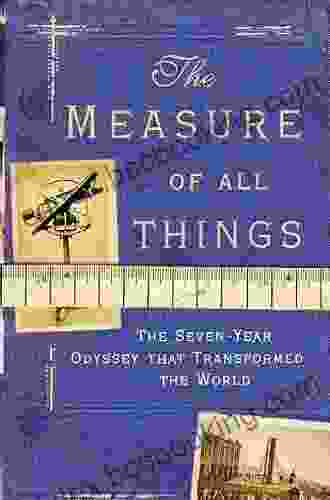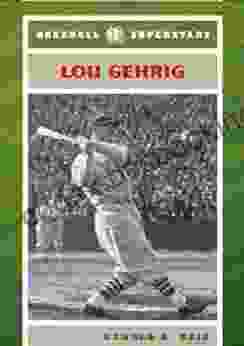The Measure of All Things: Uncovering the Lost History of Length

Length is one of the most fundamental concepts in human experience. We use it to measure everything from the height of a building to the distance between two stars. But how did we come up with the units of measurement we use today? And how have they changed over time?
4.5 out of 5
| Language | : | English |
| File size | : | 8809 KB |
| Text-to-Speech | : | Enabled |
| Screen Reader | : | Supported |
| Enhanced typesetting | : | Enabled |
| Word Wise | : | Enabled |
| Print length | : | 450 pages |
In his fascinating book The Measure of All Things, historian Ken Alder takes readers on a journey across centuries and cultures, revealing the surprising stories behind the units of measurement we use today.
Alder begins his story in ancient Egypt, where the cubit—the distance from the elbow to the tip of the middle finger—was the standard unit of length. The cubit was used to measure everything from the height of the pyramids to the length of a piece of cloth.
In Babylon, the cubit was replaced by the foot, which was based on the average length of a man's foot. The foot was divided into 12 inches, and the inch was further divided into 12 barleycorns. The barleycorn was the smallest unit of length in the Babylonian system, and it was used to measure everything from the diameter of a grain of barley to the width of a hair.
In Greece, the foot was replaced by the stade, which was the distance that a man could walk in one minute. The stade was divided into 600 feet, and the foot was further divided into 12 inches. The inch was the smallest unit of length in the Greek system, and it was used to measure everything from the length of a ship to the height of a statue.
In Rome, the foot was replaced by the passus, which was the distance that a man could take in two steps. The passus was divided into 5 feet, and the foot was further divided into 12 inches. The inch was the smallest unit of length in the Roman system, and it was used to measure everything from the width of a road to the height of a building.
In the Middle Ages, the passus was replaced by the yard, which was the distance from the tip of the nose to the end of the outstretched arm. The yard was divided into 3 feet, and the foot was further divided into 12 inches. The inch was the smallest unit of length in the medieval system, and it was used to measure everything from the length of a piece of cloth to the height of a horse.
In the Renaissance, the yard was replaced by the meter, which was based on the length of a pendulum that swings at a certain rate. The meter was divided into 100 centimeters, and the centimeter was further divided into 10 millimeters. The millimeter was the smallest unit of length in the metric system, and it was used to measure everything from the diameter of a hair to the wavelength of light.
In the Scientific Revolution, the meter was replaced by the international yard, which was based on the length of a certain metal bar. The international yard was divided into 3 feet, and the foot was further divided into 12 inches. The inch was the smallest unit of length in the international system, and it was used to measure everything from the length of a ship to the diameter of a planet.
Today, the international yard is still the standard unit of length in the United States and the United Kingdom. However, most other countries have adopted the metric system. The metric system is based on the meter, and it is divided into 100 centimeters, 1000 millimeters, and 1000 kilometers. The metric system is used to measure everything from the length of a piece of paper to the distance between two stars.
The Measure of All Things is a fascinating and informative book that sheds light on one of the most fundamental aspects of human experience. Alder's writing is clear and engaging, and he brings the history of length measurement to life with vivid anecdotes and colorful characters. The Measure of All Things is a must-read for anyone who is interested in the history of science, technology, or culture.
4.5 out of 5
| Language | : | English |
| File size | : | 8809 KB |
| Text-to-Speech | : | Enabled |
| Screen Reader | : | Supported |
| Enhanced typesetting | : | Enabled |
| Word Wise | : | Enabled |
| Print length | : | 450 pages |
Do you want to contribute by writing guest posts on this blog?
Please contact us and send us a resume of previous articles that you have written.
 Book
Book Novel
Novel Page
Page Chapter
Chapter Text
Text Story
Story Genre
Genre Reader
Reader Library
Library Paperback
Paperback E-book
E-book Magazine
Magazine Newspaper
Newspaper Paragraph
Paragraph Sentence
Sentence Bookmark
Bookmark Shelf
Shelf Glossary
Glossary Bibliography
Bibliography Foreword
Foreword Preface
Preface Synopsis
Synopsis Annotation
Annotation Footnote
Footnote Manuscript
Manuscript Scroll
Scroll Codex
Codex Tome
Tome Bestseller
Bestseller Classics
Classics Library card
Library card Narrative
Narrative Biography
Biography Autobiography
Autobiography Memoir
Memoir Reference
Reference Encyclopedia
Encyclopedia Joyce Yee
Joyce Yee Emrah Yayici
Emrah Yayici Wendy Sullivan
Wendy Sullivan Tom Hill
Tom Hill Ellie Sandall
Ellie Sandall J Patrick Boyer
J Patrick Boyer Emma Gift
Emma Gift Simba Sana
Simba Sana George Christian Pappas
George Christian Pappas Ellen Marie Wiseman
Ellen Marie Wiseman Noga Arikha
Noga Arikha Emily Herring Wilson
Emily Herring Wilson Ellen Eagle
Ellen Eagle Jason Thalken
Jason Thalken Randi Minetor
Randi Minetor Mark Pellegrini
Mark Pellegrini James P Macguire
James P Macguire Stanley H Block
Stanley H Block Peter Frase
Peter Frase Makoto Sawa
Makoto Sawa
Light bulbAdvertise smarter! Our strategic ad space ensures maximum exposure. Reserve your spot today!

 Samuel Taylor ColeridgeContracting for Services in State and Local Government Agencies Public: A...
Samuel Taylor ColeridgeContracting for Services in State and Local Government Agencies Public: A... Bret MitchellFollow ·2.2k
Bret MitchellFollow ·2.2k Easton PowellFollow ·5.6k
Easton PowellFollow ·5.6k Dion ReedFollow ·3.4k
Dion ReedFollow ·3.4k Edison MitchellFollow ·15.8k
Edison MitchellFollow ·15.8k Efrain PowellFollow ·17.8k
Efrain PowellFollow ·17.8k Timothy WardFollow ·17.4k
Timothy WardFollow ·17.4k Gabriel BlairFollow ·3.6k
Gabriel BlairFollow ·3.6k George BellFollow ·3.6k
George BellFollow ·3.6k

 Isaias Blair
Isaias BlairEscape to Sunrise Cottage: A Captivating Read You Won't...
Are you ready for a...

 Bradley Dixon
Bradley DixonWhen Baby Is Born, So Is Mother: A Comprehensive Guide to...
Giving birth is a...

 Mario Simmons
Mario SimmonsPhotographic Journal of Cruise Around South America: A...
Embark on an Extraordinary Expedition ...

 Langston Hughes
Langston HughesDream Achieved: Unlocking the Power Within to Make Your...
In the tapestry...
4.5 out of 5
| Language | : | English |
| File size | : | 8809 KB |
| Text-to-Speech | : | Enabled |
| Screen Reader | : | Supported |
| Enhanced typesetting | : | Enabled |
| Word Wise | : | Enabled |
| Print length | : | 450 pages |













